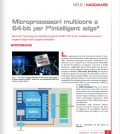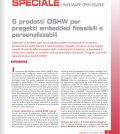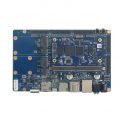Add proximity sensing to your next embedded design
-

- Tweet
- Pin It
- Condividi per email
-

Dalla rivista:
Elettronica Oggi
Autore: Yi Hang Wang, Product marketing engineer staff, Cypress Semiconductor
The use of Proximity sensing in consumer electronic devices has proven to add a “coolness” factor to the device apart from being functionally useful. It might be a worthwhile consideration to give your new designs a competitive edge in the market.
Consumer electronic devices have now become a part of everyday life. Gone are the days when mobile phones were a rarity and PDAs could be afforded by a minority. With these embedded electronic devices becoming ubiquitous, manufacturers of such devices are finding new ways of packing more features and functionality to enhance their usability and be more competitive in the market.
One such feature that is finding its way into a number of embedded devices is proximity sensing. Proximity sensing in the world of embedded devices is the detection of the presence of a human finger or hand near an electronic gadget. This feature of proximity sensing is being adopted by numerous industries for a variety of applications.
Use of Proximity Sensing
Proximity sensing has found immediate adopters in the hand-held, battery-powered devices industry. The feature is seen in the latest mobile phones and music players. The primary function of proximity sensing in these devices is power saving. The LCD display on the music player or phone remains off as long as it does not detect the presence of a human finger or hand near it. As a result of the display staying off, only the CPU draws power from the battery and power is not drawn to drive the LCD display. As soon as the device detects the presence of the human hand, the display illuminates, showing either the present song being played or caller information. The average power consumed is thus reduced, thereby increasing battery life.
Proximity sensing has become a common feature in home automation. It is used to turn on table lamps by waving a hand in front of it. Water faucets turn on when the hand is placed under it. Microwaves and refrigerators with displays on them remain blank as long as a user is not in its vicinity. When a user nears it, the display and lights turn on. New home automation systems are also adopting this feature. Touch screen displays used for lighting and appliance control are configured to behave as a digital photo frame under normal circumstances. As soon as someone nears it, it changes its display to its control panel and illuminating hidden touch sensor buttons. Proximity sensing can also be used for security by setting off an alarm if it detects an unauthorized presence either near a door knob or a window pane. Extend this idea to building smarter utensils and appliances. Utensils that could indicate the temperature of the liquids inside it by changing surface color when a hand neared it. This could save children from nasty burns around the kitchen. Bath tubs that could warn you that the water is too cold even before you put a foot inside it.
Proximity sensing can be adopted by the automobile sector to build smarter cars. Envision a car that sensed a driver in its vicinity and unlocked the door for him as he approached the handle. Apart from this, it would turn on the ignition and the AC or heater based on the temperature inside the car. The car would warn the driver if the handle or the shifters were too hot when his hand approached it. It could also instruct the driver what a knob or a button in the car did if it detected the presence of his hand near it. Just when you thought cars could not get any smarter, emerging technology such as proximity sensing is stretching the limits.
Proximity sensing is used to display hidden touch sense buttons in keyboards. Mice remain in sleep mode until it detects the presence of a hand. It then wakes up, turns on its radio to pair with the PC and is ready for operation. This allows for better battery life. Proximity based buttons could replace mechanical buttons to open laptops when shut. This could be extended to include refrigerator doors, microwaves and cell phones.
Methods of proximity sensing
A number of technologies exist to carry out proximity sensing including, resistive, inductive, capacitive, optical, acoustic and visual methods. Each of these technologies has its advantages and disadvantages. Picking one against the other depends on the specific application, cost and usability. This article will discuss how to implement a capacitive proximity sensor.
To understand how capacitive proximity sensing works, consider the cross section of a capacitive sensing element as shown (Fig. 1). The conductive copper areas and conductive sensors are below an overlay material. Two conductive elements in close proximity of each other create a capacitance called parasitic capacitance. The parasitic capacitance is created by the coupling of the sensor pad and the ground plane. The parasitic capacitance is usually in the order of 10pF to 300 pF. The proximity of the sensor and the ground planes also creates a fringe electric field that passes through the overlay. When a conductive object like the human finger is brought near the fringing electric fields, it adds conductive surface area to the capacitive system. This change in the overall capacitance of the system is used to detect the presence of the finger near the capacitive sensor element.
Fig. 1 – Cross section of a capacitive sensing elements
Fig. 2 – When a conductive object like an human finger is brought near fringing electric fields
Detecting and measuring the capacitance change
The accuracy and reliability of the proximity sensor depends on accurate measurement of the changes in the capacitance of the system. A number of methods exist for the same. The commonly used ones are Charge Transfer, Successive Approximation, Sigma-Delta and Mutual Capacitance measurements, each having its advantages and disadvantages. The more commonly adopted techniques on present capacitive sensing ICs are Successive Approximation (CSA) and Sigma-Delta (CSD). Both methods use switched capacitor circuitry and use an external modification capacitor (CMod).
In the CSA method (Fig. 3), the switched capacitor network charges CMod. The voltage on CMod is then routed through a low-pass filter into a comparator, where it is compared to a reference voltage. A counter clocked by an oscillator is gated by the output of the comparator, the output of which is processed to determine the status of the sensor. CSA requires very few external components. It is also not affected by power-supply transients.
Fig. 3 – CSA block diagram
In the CSD method (Fig. 4), the switched capacitor input stage contains the sensor capacitor CX. The switched capacitor network is between VDD and the voltage at CMod. A Pseudo-Random Generator controls the switching frequency of the switched capacitor network. CMod continuously charges and discharges. When the comparator trips, the bleed resistor switch closes, discharging CMod until a new value is stored in the synchronization latch. The bit stream output of the latch is then ‘ANDed’ with the PWM and enables a counter. The output of the counter is processed to determine the status of the sensor. CSD is ideally suited for white goods, industrial and automotive applications since it is least susceptible to electromagnetic interference and radiated emissions.
Fig. 4 – CSD block diagram
Advantages of capacitive proximity sensing over other sensing methods
• Range of finger presence detection is fairly high (30 cm+ with an external antenna senso
r and 10 cm+ without an antenna)
• Sensitivity is higher than sensing methods like resistive or inductive
• Inexpensive as sensors can be constructed from different media, such as copper, external wire sensor, ITO and printed ink.
• Minimum element size
• Temperature stability
• Design flexibility
• Resistant to environmental factors: water, temperature, humidity
• Works with a variety of non-conductive overlay materials like glass, with varying thicknesses
• High reliability and durability since they act as replacements to their mechanical counterparts
Potential drawbacks
• The sensed element has to be conductive. This makes it work well to detect human tissue presence near it. However, it might not detect a hand approach it when the user has rubber gloves on
• When the conductive object remains in the vicinity of the sensor, the system could eventually recalculate its parasitic capacitance to include that induced by the hand in its vicinity. This could result in future false detects. This can however easily be remedied in software
• The detection range of capacitive proximity sensing decreases drastically in the presence of metal objects near the sensor. A way to overcome this issue is detailed below
Increasing detection distance in the presence of metal objects
In the presence of metal objects, the range of capacitive proximity detection can decrease almost 15-fold. The primary reason for this is that the metal object increases the sensor stray capacitance. Such a stray capacitance reduces the proximity response value by providing a higher full scale range. This often requires reduction in operating frequency, in turn, decreasing detection distance. The grounded metal plane also catches part of the sensor electric field and reduces the added finger capacitance.
Since most white goods have metal casings, this feature can be detrimental to such designs. However, the influence of a metal surface on a sensor is decreased by placing a shield electrode between the proximity detection sensor and the metal object, with the shield electrode having the same potential as the sensor. This is a fairly effective solution to the problem.
Cypress has a range of products and tools that help a designer incorporate both capacitive proximity sensing as well as general capacitive touch button sensors into his design very easily. The Capsense devices are part of the Programmable System on Chip (PSoC®) suite of products of Cypress. Cypress has a range of development tools that allow for quick prototyping and development. For example, the IDE for Capsense development, PSoC Designer provides a setup wizard for easy routing of capacitive sensors to GPIO pins. It also has a tuner to set the threshold and noise parameters based on the specific hardware sensor layout. High level software tools assist in configuring these sensors to achieve the desired results, fairly easily. For more information on the Cypress Capsense range of products, visit http://www.cypress.com/capsense/
References
• Proximity Detection in the Presence of Metal Objects (AN42851) – Victor Kremin, Andriy Ryshtun, Vasyl Mandzij
• Article titled “Capacitive sensing techniques and considerations: The basics” by Ryan Seguine (Automotive Design Line)
Contenuti correlati
-
Nuovi display dvLED da DATA MODUL
I nuovi display dvLED (LED Direct View) di DATA MODUL sono stati sviluppati appositamente per applicazioni indoor in cui è importante attirare l’attenzione sullo schermo e sul suo contenuto. Questi dispositivi sono utilizzabili per applicazioni come display...
-
Microprocessori multicore a 64-bit per l’“intelligent edge”
Microchip Technology ha introdotto la gamma di MPU PIC 64 per soddisfare le crescenti esigenze degli odierni progetti embedded Leggi l’articolo completo su EMB93
-
5 prodotti OSHW per progetti embedded flessibili e personalizzabili
Optare per un hardware open source significa credere nel potenziale di innovazione, accelerazione e trasformazione di ciascun prodotto o progetto, che deriva da una maggior capacità di controllo sulla tecnologia e dalla condivisione di conoscenze. Le prospettive...
-
DATA MODUL: TFT trasparenti per applicazioni speciali
L’offerta di display con dimensioni di 12,3 pollici e 20,8 pollici di DATA MODUL è stata estesa con l’aggiunta di nuovi display di Japan Display (JDI). Si tratta dei display Rælclear caratterizzati da un livello di trasmissione...
-
Gli alimentatori ad alta affidabilità per applicazioni industriali di COSEL
COSEL ha ampliato la sua offerta con gli alimentatori AC/DC ad alta affidabilità della serie PDA, destinati ad applicazioni industriali. La nuova serie utilizza una topologia quasi risonante con un numero limitato di componenti con l’obiettivo di...
-
AMD annuncia Embedded+
Embedded+ è il nome di una nuova piattaforma architetturale di AMD che combina i processori AMD Ryzen Embedded con i SoC adattivi Versal su un’unica board integrata. L’obiettivo è quello di accelerare il time-to-market delle applicazioni Edge...
-
Le soluzioni Embedded: istruzioni per l’uso
Di Sandro Mascetti – CEO di MAS Elettronica Nell’attuale scenario di Industria 4.0. le soluzioni embedded sono diventate un must have. Grazie alle numerose applicazioni che offrono, queste soluzioni sono molto diffuse e conosciute. I sistemi embedded...
-
Le risorse di Mouser per l’embedded
Mouser Electronics mette a disposizione dei progettisti una piattaforma online con una serie di risorse per il mondo embedded. Si tratta del centro di risorse sull’Elaborazione Embedded che viene costantemente aggiornato con informazioni sulle applicazioni embedded attraverso...
-
Sicurezza: un problema volutamente ignorato
Nel momento in cui le normative e i regolamenti che disciplinano la sicurezza entrano in vigore non solo in Europa, ma in tutto il mondo, le aziende devono necessariamente aggiungere funzioni atte a garantire la sicurezza dei...
-
Come rendere sicuro e semplice l’aggiornamento OTA con TUF
L’ambiente dei dispositivi embedded è ancora il bersaglio di continue minacce. Più un dispositivo è connesso e più funzioni intelligenti offre all’utente, maggiore sarà la “superficie di attacco” per eventuali minacce informatiche Leggi l’articolo completo su Embedded...
Scopri le novità scelte per te x
-
Nuovi display dvLED da DATA MODUL
I nuovi display dvLED (LED Direct View) di DATA MODUL sono stati sviluppati appositamente per applicazioni indoor...
-
Microprocessori multicore a 64-bit per l’“intelligent edge”
Microchip Technology ha introdotto la gamma di MPU PIC 64 per soddisfare le crescenti esigenze degli odierni...
News/Analysis Tutti ▶
-
Infineon espande la produzione in Asia
Infineon Technologies ha iniziato i lavori per la realizzazione di un nuovo sito di...
-
Mouser Electronics premiata da Bourns
Bourns ha assegnato a Mouser Electronics il riconoscimento Distributor of the Year nella categoria...
-
Le soluzioni di Murata a MWC
Murata esporrà alla prossima edizione del Mobile World Congress (MWC), che si svolgerà a...
Products Tutti ▶
-
OMRON: nuovi relè DC per correnti fino a 200 A
Omron Electronic Components Europe ha ampliato la sua offerta di relè di potenza per...
-
DATA MODUL integra un sensore radar nei monitor
DATA MODUL offre ai suoi clienti monitor con sensori di presenza basati su radar...
-
La seconda generazione di dispositivi Ensemble di Alif
Alif Semiconductor ha annunciato la seconda generazione della famiglia di prodotti Ensemble, utilizzabili per...



















